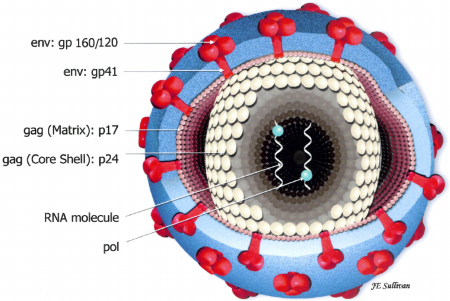
Human immunodeficiency virus (HIV) is a complex RNA virus of the genus Lentivirus within the Retroviridae family. HIV (human immunodeficiency virus) is composed of two strands of RNA, 15 types of viral proteins, and a few proteins from the last host cell it infected, all surrounded by a lipid bilayer membrane. Together, these molecules allow the virus to infect cells of the immune system and force them to build new copies of the virus. Each molecule in the virus plays a role in this process, from the first steps of viral attachment to the final process of budding. HIV is an approximately 100 nm icosahedral structure with 72 external spikes that are formed by the two major envelope glycoproteins gp120 and gp41. Two major types of the AIDS virus, HIV- 1 and HIV-2, have been identified. The major serological differences reside in the surface protein gp120. HIV-1 and HIV-2 are further separated into subtypes or ‘clades’ due to the marked variability in the V3 (variable region) of the gp120 protein. The lipid bilayer is also studded with a number of host-cell proteins during the budding process. HIV has a characteristic dense, cone-shaped nucleocapsid composed of the core protein p24. This nucleocapsid harbours two identical copies of the 9.8 kb single-stranded positive polarity RNA genome which are associated with the viral enzymes reverse transcriptase (RT), RNase H, integrase, and protease. HIV encodes 3 structural genes and 6 regulatory genes.
Structural genes:
1. Group-Specific Antigen (Gag): p24, p7, p17)
2. Envelope (Env): gp 120, gp 41
2.1. On the basis of gp120 genes, HIV is divided into subtypes (clades)
2.2. gp120 binds to CD4 on CD4+ T lymphocytes and cells of the monocyte/macrophage lineage and coreceptors (CCR5 and CXCR4)
2.3. gp41 mediate fusion between the cellular and viral membranes.
3. Polymerase (Pol): Reverse transcriptase, integrase, protease
In addition to structural genes HIV has genes whose products contribute to the complex regulation and replication of the virus. Of particular interest is the Nef (negative factor) protein. Deletions and mutations of this protein have been found in some HIV-infected individuals characterized as long-term non-progressors.
Regulatory genes found in HIV Required for replication
1. Tat: Activation of transcription of viral genes
2. Rev: Transport of late mRNAs from the nucleus to the cytoplasm
Not required for replication
1. Nef: Decreases CD4 and MHC class I protein expression in virus-infected cells (?mutation in the nef gene).
2. Vif: Enhances viral infectivity
3. Vpr: Transports viral core from the cytoplasm into the nucleus
4. Vpu: Enhances virion release from the cell.
Host species: Human
Isotype: IgG1-kappa
Applications: Research Grade Biosimilar
Expression system: Mammalian cells
Host species: Mosue
Isotype: IgG2a
Applications: ELISA, FCM, IF, WB
Accession: P04578
Host species: Rabbit
Isotype: IgG
Applications: ELISA, WB
Accession: L8B302
Host species: Human
Isotype: IgG1-lambda
Applications: Research Grade Biosimilar
Expression system: Mammalian Cells
Isotype: Fusion - [CD4 (LFA3, lymphocyte function associated antigen 3)]2 - IGHG1 Fc (Fragment constant)
Applications: Research Grade Biosimilar
Expression system: Mammalian Cells
Accession: P01730
Isotype: VHH-8His-Cys-tag
Applications: Research Grade Biosimilar
Expression system: Mammalian Cells
Accession: Q03805